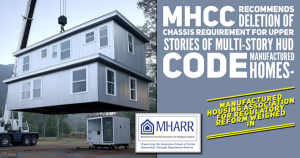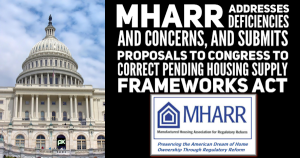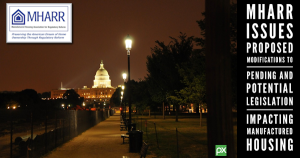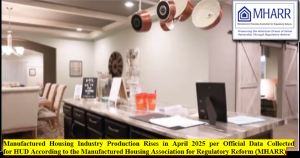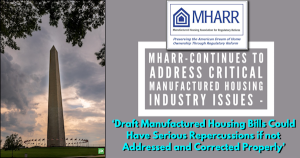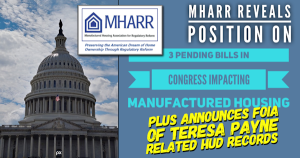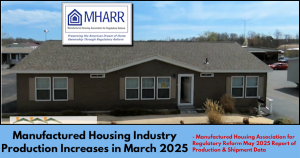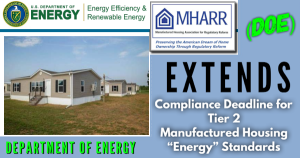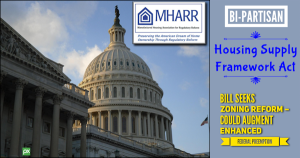HUD and FHFA Trumpet “Show” Spending While Avoiding Real Solutions”
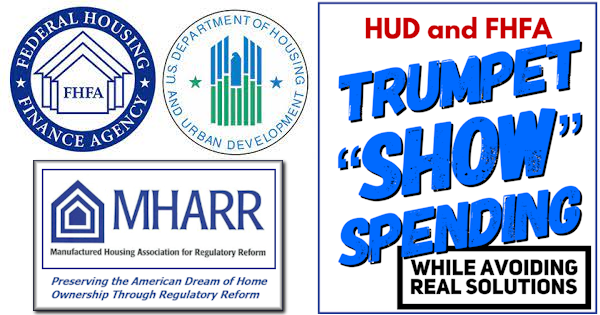
Washington, D.C., March 8, 2024 – Recent announcements by federal agencies are touting millions of dollars in spending on affordable housing, including some nominally targeted at HUD Code manufactured homes. Yet, as the Manufactured Housing Association for Regulatory Reform (MHARR) has consistently pointed out – and documented, both in its July 2022 White Paper on the “Exploitation of Federal Housing Finance and Mortgage Funding Assistance Programs and Potential Solutions” and its February 28, 2024 package, “Principal Bottlenecks Suppressing Manufactured Housing” – such spending rarely, if ever, “reaches the ground” for consumers of new affordable, mainstream manufactured housing. This is particularly relevant at a time when the HUD Code manufactured housing market has been mired for more than a year in a double-digit production slump.
Specifically, in separate statements issued on February 28 and 29, 2024, the Federal Housing Finance Agency (FHFA) announced the transfer of $301 million from Fannie Mae and Freddie Mac to the U.S. Department of Housing and Urban Development (HUD) Housing Trust Fund and the U.S. Treasury Department’s Capital Magnet Fund (copy attached), while HUD announced the creation of a $225 million fund to “preserve and revitalize manufactured housing and manufactured housing communities” (copy attached). According to HUD, the $225 million competitive grant program will support “repairs and rehabilitation of homes, replacement of dilapidated units, infrastructure upgrades … improvements to increase community resilience in the face of extreme weather, planning activities to support manufactured housing communities, and services for homeowners including … counseling, eviction prevention, and activities that support resident-owned management structures.”
While these programs are presumably well-intended and may benefit some consumers already living in HUD Code manufactured homes or pre-HUD Code “mobile homes,” it is highly unlikely that the bulk of these funds will “reach the ground” to benefit those consumers – and particularly those outside of existing land-lease communities – who wish to purchase new manufactured homes. As a result, they are unlikely to revitalize manufactured housing production to any market-significant degree.
The reasons — as MHARR has already extensively detailed in the above-referenced analyses — are quite simple. The reality is that: (1) because of discriminatory and exclusionary zoning edicts in many areas of the country; and (2) because of a lack of a competitive consumer financing, driven by the absence of securitization and secondary market support from Fannie Mae and Freddie Mac (plus the added factor of looming high-cost federal energy standards), the HUD Code market is – and has been – underperforming for decades. Put differently, instead of producing and selling hundreds of thousands of homes each year in the face of a growing, long-term affordable housing “crisis,” manufactured housing production this century has either been mired below 100,000 homes per year, or has exceeded that benchmark by only a relatively small margin.
Instead of spending millions of taxpayer dollars on programs that will not significantly expand the number of Americans who can place a manufactured home in a town, neighborhood or area of their choice, or who can qualify for competitively-priced manufactured housing personal property loans, both HUD and FHFA should go to the root of the problem affecting the mainstream manufactured housing market, and enforce the good laws – right under their noses – that could (and will) cure both the zoning and consumer financing bottlenecks. Fully and properly implementing the enhanced federal preemption of the Manufactured Housing Improvement Act of 2000 and the Duty to Serve (DTS) mandate, will help to clear away these obstacles, opening new markets – and expanding existing ones – to make affordable, mainstream manufactured housing available for millions more Americans.
Going forward, the entire industry – and more particularly the post-production segment of the industry and its national representation in Washington, D.C. (the Manufactured Housing Institute) — will need to prioritize these issues and aggressively seek specific concrete actions from HUD and FHFA in order to allow mainstream, affordable manufactured housing to reach its full potential in satisfying the affordable housing needs of millions of American families.
The Manufactured Housing Association for Regulatory Reform is a Washington, D.C.- based national trade association representing the views and interests of independent producers of federally-regulated manufactured housing.
Attachments
mharr.fhfafundingnr-MHARR-Housing-Trust-fund.pdf
2024/03/mharr.hudfundingnr-MHARR.pdf
Washington, D.C., March 8, 2024 – Recent announcements by federal agencies are touting millions of dollars in spending on affordable housing, including some nominally targeted at HUD Code manufactured homes. Yet, as the Manufactured Housing Association for Regulatory Reform (MHARR) has consistently pointed out – and documented, both in its July 2022 White Paper on the “Exploitation of Federal Housing Finance and Mortgage Funding Assistance Programs and Potential Solutions” and its February 28, 2024 package, “Principal Bottlenecks Suppressing Manufactured Housing” – such spending rarely, if ever, “reaches the ground” for consumers of new affordable, mainstream manufactured housing. This is particularly relevant at a time when the HUD Code manufactured housing market has been mired for more than a year in a double-digit production slump.
Specifically, in separate statements issued on February 28 and 29, 2024, the Federal Housing Finance Agency (FHFA) announced the transfer of $301 million from Fannie Mae and Freddie Mac to the U.S. Department of Housing and Urban Development (HUD) Housing Trust Fund and the U.S. Treasury Department’s Capital Magnet Fund (copy attached), while HUD announced the creation of a $225 million fund to “preserve and revitalize manufactured housing and manufactured housing communities” (copy attached). According to HUD, the $225 million competitive grant program will support “repairs and rehabilitation of homes, replacement of dilapidated units, infrastructure upgrades … improvements to increase community resilience in the face of extreme weather, planning activities to support manufactured housing communities, and services for homeowners including … counseling, eviction prevention, and activities that support resident-owned management structures.”
While these programs are presumably well-intended and may benefit some consumers already living in HUD Code manufactured homes or pre-HUD Code “mobile homes,” it is highly unlikely that the bulk of these funds will “reach the ground” to benefit those consumers – and particularly those outside of existing land-lease communities – who wish to purchase new manufactured homes. As a result, they are unlikely to revitalize manufactured housing production to any market-significant degree.
The reasons — as MHARR has already extensively detailed in the above-referenced analyses — are quite simple. The reality is that: (1) because of discriminatory and exclusionary zoning edicts in many areas of the country; and (2) because of a lack of a competitive consumer financing, driven by the absence of securitization and secondary market support from Fannie Mae and Freddie Mac (plus the added factor of looming high-cost federal energy standards), the HUD Code market is – and has been – underperforming for decades. Put differently, instead of producing and selling hundreds of thousands of homes each year in the face of a growing, long-term affordable housing “crisis,” manufactured housing production this century has either been mired below 100,000 homes per year, or has exceeded that benchmark by only a relatively small margin.
Instead of spending millions of taxpayer dollars on programs that will not significantly expand the number of Americans who can place a manufactured home in a town, neighborhood or area of their choice, or who can qualify for competitively-priced manufactured housing personal property loans, both HUD and FHFA should go to the root of the problem affecting the mainstream manufactured housing market, and enforce the good laws – right under their noses – that could (and will) cure both the zoning and consumer financing bottlenecks. Fully and properly implementing the enhanced federal preemption of the Manufactured Housing Improvement Act of 2000 and the Duty to Serve (DTS) mandate, will help to clear away these obstacles, opening new markets – and expanding existing ones – to make affordable, mainstream manufactured housing available for millions more Americans.
Going forward, the entire industry – and more particularly the post-production segment of the industry and its national representation in Washington, D.C. (the Manufactured Housing Institute) — will need to prioritize these issues and aggressively seek specific concrete actions from HUD and FHFA in order to allow mainstream, affordable manufactured housing to reach its full potential in satisfying the affordable housing needs of millions of American families.
The Manufactured Housing Association for Regulatory Reform is a Washington, D.C.- based national trade association representing the views and interests of independent producers of federally-regulated manufactured housing.



